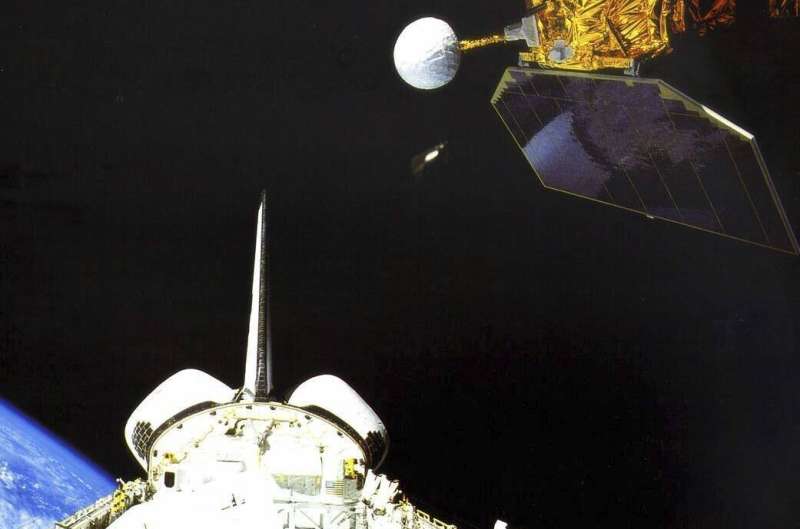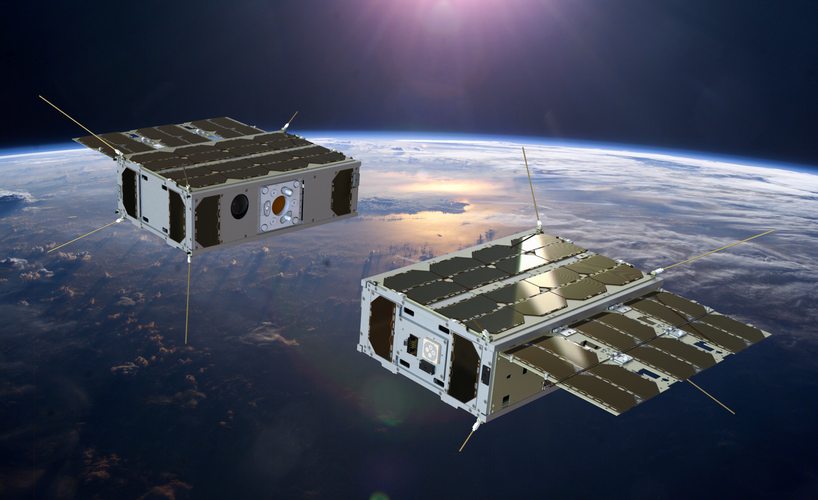
Copernical Team
Old NASA satellite falls harmlessly from sky off Alaska

Sentinel-1 and AI uncover glacier crevasses

Scientists have developed a new Artificial Intelligence, or AI, technique using radar images from Europe’s Copernicus Sentinel-1 satellite mission, to reveal how the Thwaites Glacier Ice Tongue in West Antarctica is being damaged by squeezing and stretching as it flows from the middle of the continent to the coast. Being able to track fractures and crevasses in the ice beneath the overlying snow is key to better predicting the fate of floating ice tongues under climate change.
Join the hive: send your ideas for CubeSat swarms

We all know the saying that there is strength in numbers. The next revolution in space technology could be the use of swarms of tiny spacecraft, called CubeSats, that work together to achieve things greater than what any lone spacecraft can. CubeSats, assemble!
OneWeb to launch 40 satellites with SpaceX
 OneWeb, the low Earth orbit (LEO) satellite communications company, will launch 40 satellites with SpaceX no earlier than Sunday, 8 January 2023, from Cape Canaveral Space Force Station in Florida. This launch will be OneWeb's sixteenth to date and its second with SpaceX following a successful launch in December, keeping the company on track to deliver global coverage in 2023.
This launch
OneWeb, the low Earth orbit (LEO) satellite communications company, will launch 40 satellites with SpaceX no earlier than Sunday, 8 January 2023, from Cape Canaveral Space Force Station in Florida. This launch will be OneWeb's sixteenth to date and its second with SpaceX following a successful launch in December, keeping the company on track to deliver global coverage in 2023.
This launch General Atomics awarded contract from Advanced Space for Cislunar Spacecraft for AFRL Oracle Program
 General Atomics Electromagnetic Systems (GA-EMS) reports that it is under contract to Advanced Space LLC to build an ESPA-Grande class satellite, perform payload integration, and space vehicle test for the Air Force Research Laboratory (AFRL) Oracle spacecraft program. Oracle will demonstrate space situational awareness and Position, Navigation and Timing (PNT) techniques using advanced technolo
General Atomics Electromagnetic Systems (GA-EMS) reports that it is under contract to Advanced Space LLC to build an ESPA-Grande class satellite, perform payload integration, and space vehicle test for the Air Force Research Laboratory (AFRL) Oracle spacecraft program. Oracle will demonstrate space situational awareness and Position, Navigation and Timing (PNT) techniques using advanced technolo Rock Robotics Rock Base X offers 1600 channels across multiple constellations
 ROCK Robotic announced the availability of ROCK Base, a state-of-the-art, triple-band multi-constellation RTK/GNSS base station. ROCK has also joined the Web3 GEODNET initiative, the world's largest decentralized GNSS reference network.
The combined solution will support critical applications in civil surveying, high-definition mapping and digital twin creation, as well as many next-genera
ROCK Robotic announced the availability of ROCK Base, a state-of-the-art, triple-band multi-constellation RTK/GNSS base station. ROCK has also joined the Web3 GEODNET initiative, the world's largest decentralized GNSS reference network.
The combined solution will support critical applications in civil surveying, high-definition mapping and digital twin creation, as well as many next-genera New discovery of sunscreen-like chemicals in fossil plants reveals UV radiation played a part in mass extinction events
 New research has uncovered that pollen preserved in 250 million year old rocks contain compounds that function like sunscreen, these are produced by plants to protect them from harmful ultraviolet (UV-B) radiation. The findings suggests that a pulse of UV-B played an important part in the end Permian mass extinction event.
Scientists from the University of Nottingham, China, Germany and th
New research has uncovered that pollen preserved in 250 million year old rocks contain compounds that function like sunscreen, these are produced by plants to protect them from harmful ultraviolet (UV-B) radiation. The findings suggests that a pulse of UV-B played an important part in the end Permian mass extinction event.
Scientists from the University of Nottingham, China, Germany and th Unpacking the "black box" to build better AI models
 When deep learning models are deployed in the real world, perhaps to detect financial fraud from credit card activity or identify cancer in medical images, they are often able to outperform humans.
But what exactly are these deep learning models learning? Does a model trained to spot skin cancer in clinical images, for example, actually learn the colors and textures of cancerous tissue, or
When deep learning models are deployed in the real world, perhaps to detect financial fraud from credit card activity or identify cancer in medical images, they are often able to outperform humans.
But what exactly are these deep learning models learning? Does a model trained to spot skin cancer in clinical images, for example, actually learn the colors and textures of cancerous tissue, or IXPE Team Profile; LASP at Colorado-Boulder
 As NASA's Imaging X-ray Polarimetry Explorer mission explores black holes, neutron stars, and other cosmic phenomena - helping to answer fundamental questions about extreme space environments - it relies on the mission operations team at the Laboratory for Atmospheric and Space Physics, or LASP.
Some 700 people - engineers, scientists, mission-operations personnel and data specialists - st
As NASA's Imaging X-ray Polarimetry Explorer mission explores black holes, neutron stars, and other cosmic phenomena - helping to answer fundamental questions about extreme space environments - it relies on the mission operations team at the Laboratory for Atmospheric and Space Physics, or LASP.
Some 700 people - engineers, scientists, mission-operations personnel and data specialists - st Astronomers use 'little hurricanes' to weigh and date planets around young stars
 Little 'hurricanes' that form in the discs of gas and dust around young stars can be used to study certain aspects of planet formation, even for smaller planets which orbit their star at large distances and are out of reach for most telescopes.
Researchers from the University of Cambridge and the Institute for Advanced Study have developed a technique, which uses observations of these 'hur
Little 'hurricanes' that form in the discs of gas and dust around young stars can be used to study certain aspects of planet formation, even for smaller planets which orbit their star at large distances and are out of reach for most telescopes.
Researchers from the University of Cambridge and the Institute for Advanced Study have developed a technique, which uses observations of these 'hur 
